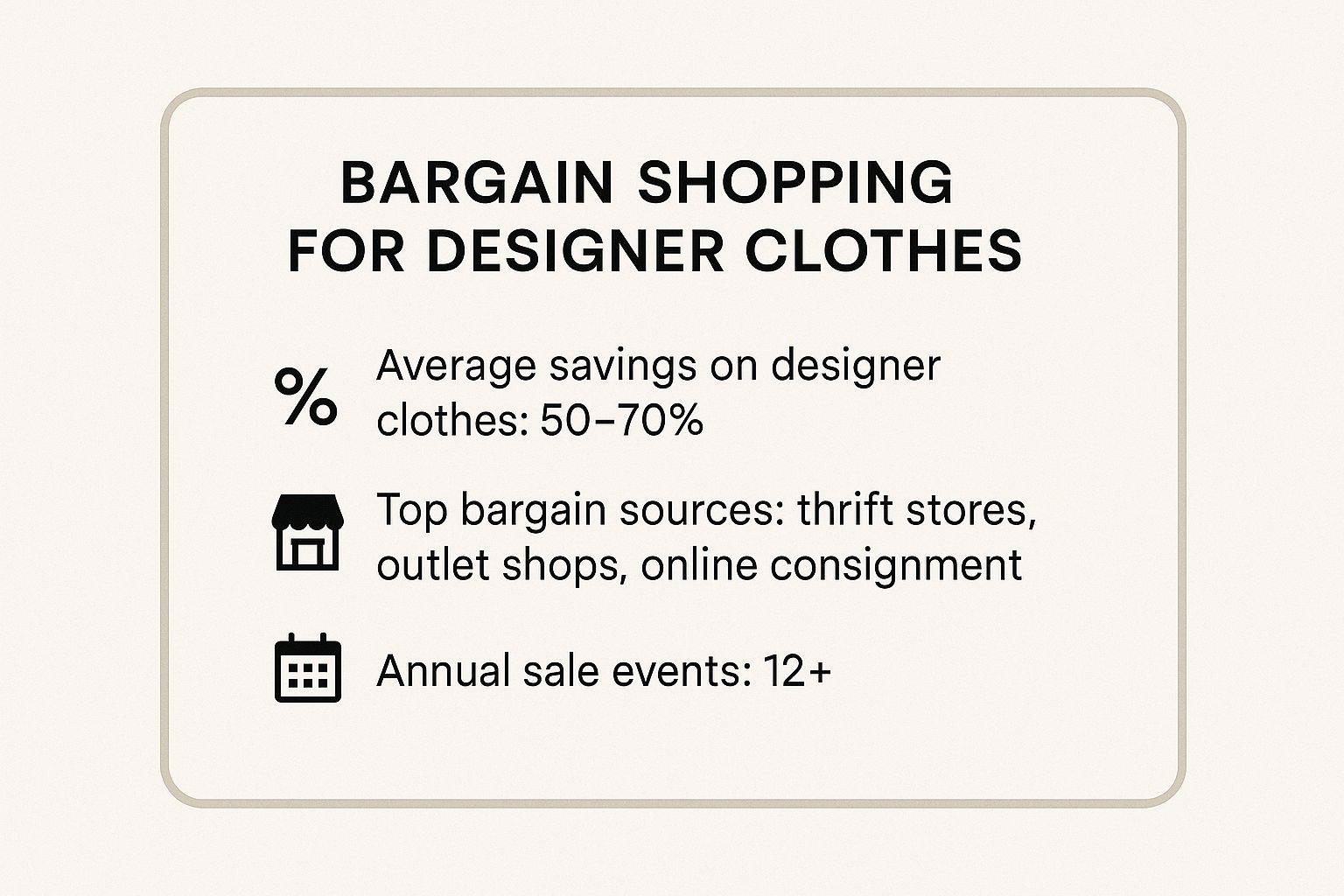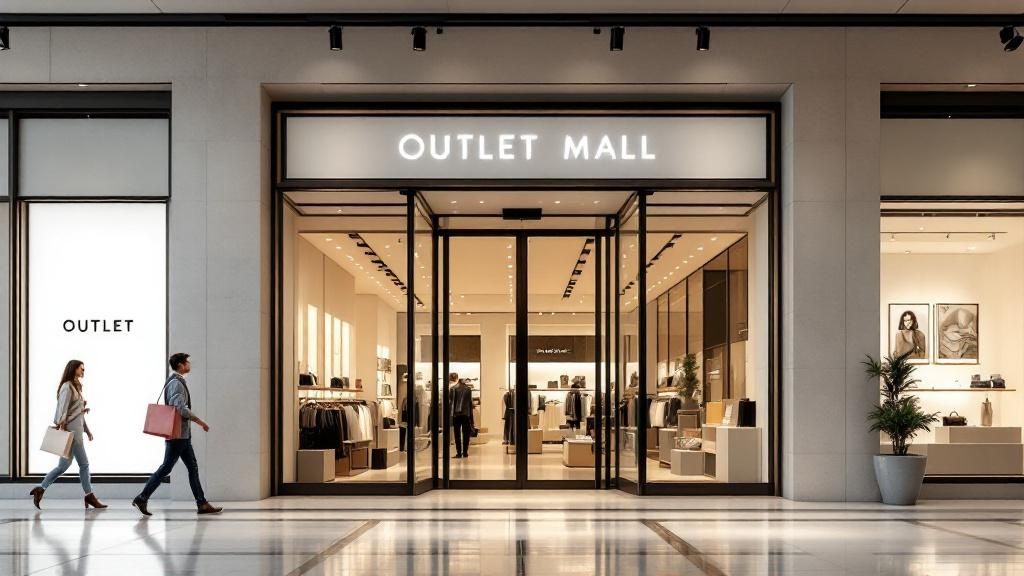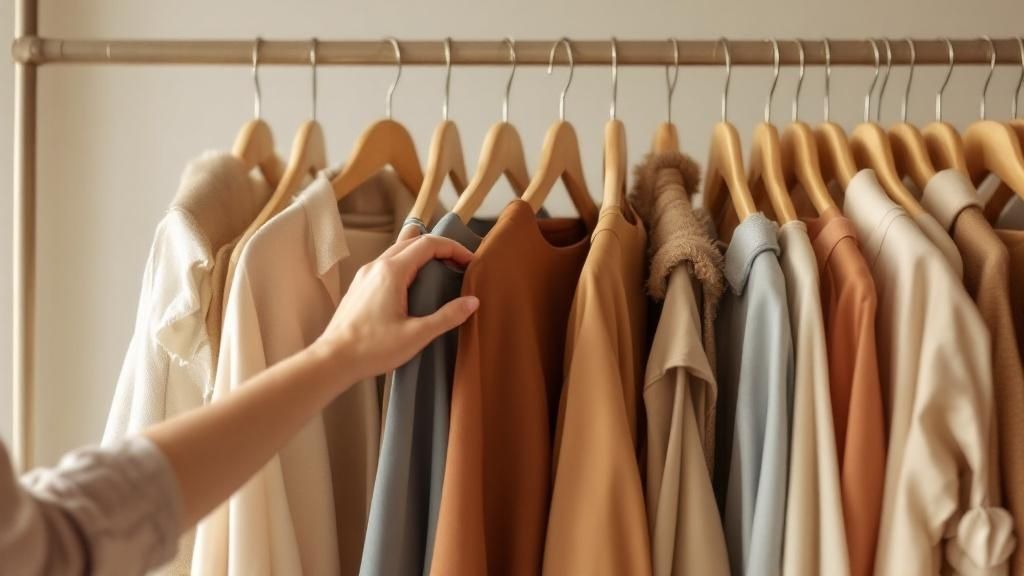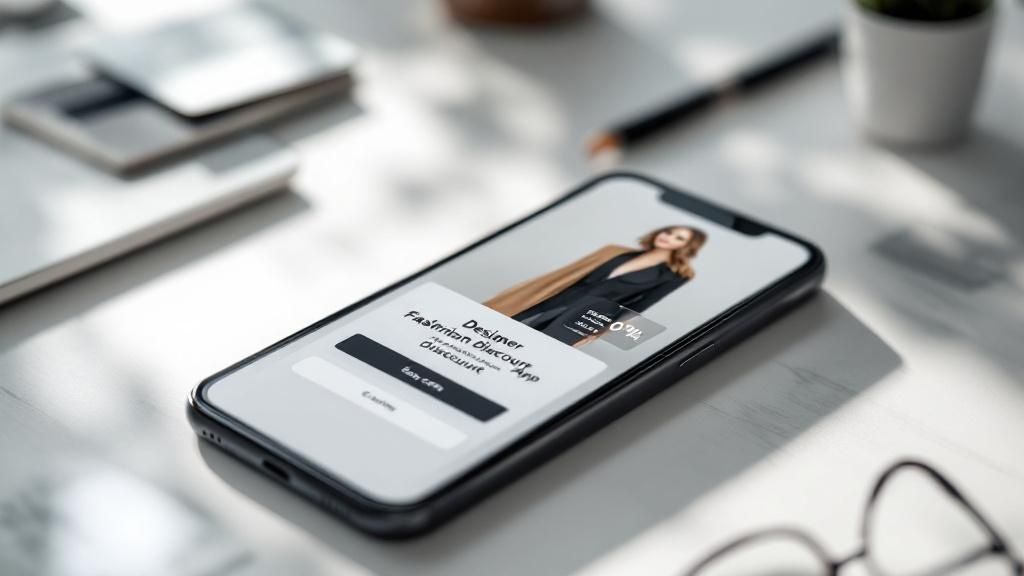Building a designer wardrobe without the sticker shock isn't a pipe dream—it's all about smart strategy. Forget paying full price. The real secret lies in knowing where and when to shop. It's about shifting your focus to luxury resale, patiently waiting for those end-of-season sales, and exploring the treasure troves of designer outlets and sample sales. With this approach, you can curate a high-end closet for a fraction of what you'd expect.
Your Guide to Building a Designer Wardrobe for Less
So, you're dreaming of a closet filled with those iconic labels but don't want to empty your bank account? You've come to the right place. I'm going to pull back the curtain and show you exactly how seasoned fashion lovers and I build our collections affordably. We'll walk through the best strategies, from mastering the art of the online resale market to timing your visit to a sample sale perfectly.
This isn't about chasing fast-fashion fads. It's about making smart, lasting investments in your personal style. You'll learn the core principles for sourcing genuine designer pieces at prices that make sense.
The big secret? Luxury fashion is surprisingly accessible if you have the right know-how and a bit of patience. A strategic mindset will always beat a massive budget.
The Core Principles of Affordable Luxury
Before we jump into the tactics, let's get our mindset right. Finding deals on designer clothing isn't about luck; it's about intentional planning. This means understanding the retail cycle, knowing what a good value looks like, and focusing on building a wardrobe that truly works for you. A classic, well-made coat you can wear for a decade is a much better investment than a trendy top you'll only wear for one season.

As you can see, saving over 50% on designer pieces is completely achievable when you use the right channels.
To give you a quick overview, I’ve put together a table summarizing the most effective ways to score discounted designer wear. It breaks down what kind of savings you can expect and which strategy might be best for you.
Top Strategies for Finding Discounted Designer Wear
| Strategy | Typical Discount Range | Best For | Key Tip |
|---|---|---|---|
| Luxury Resale | 30% - 70% | Finding past-season gems and rare items. | Always verify authenticity and check seller reviews. |
| End-of-Season Sales | 40% - 60% | Nabbing brand-new items at a lower price. | Be ready to shop the moment the sale drops. |
| Designer Outlets | 30% - 75% | Everyday basics and outlet-specific collections. | Inspect items carefully for any minor defects. |
| Sample Sales | 50% - 90% | Scoring incredible deals on one-of-a-kind pieces. | Go in with a plan and be prepared for crowds. |
Ultimately, a great strategy starts with building a foundation of timeless items. Focusing on quality over quantity not only saves you money in the long run but also helps you develop a more sophisticated and sustainable personal style. If you need some ideas, check out our guide to building a collection of classic winter versatile pieces that will anchor your wardrobe for years.
Navigating the Luxury Resale Market Like a Pro

If you're serious about scoring designer pieces for less, the pre-owned market is where the real magic happens. Forget dusty thrift store bins; we're talking about a thriving, sophisticated world where you can find incredible clothing, often in mint condition, for 30% to 70% off what it cost brand new.
This isn't just about getting a good deal. It’s your second chance at that sold-out runway piece you missed or a classic from a few seasons ago that you still dream about.
And I'm not the only one who thinks so. The global luxury resale market was recently valued at a staggering USD 31.28 billion and is on track to more than double. That tells you just how many smart shoppers are turning to secondhand to build their dream wardrobes. You can get the full scoop on the market growth projections and insights on Proficient Market Insights if you're curious.
Knowing Where to Look: The Different Types of Resale Sites
Your first step is getting to know the landscape. There are really two main kinds of resale platforms, and where you shop will completely change your experience.
-
Curated Consignment Sites: Think of places like The RealReal, Vestiaire Collective, and Fashionphile. These guys act as the expert middleman. Sellers send them their items, and the site's team professionally photographs, describes, and—most importantly—authenticates everything before it goes live. This gives you a massive sense of security.
-
Peer-to-Peer (P2P) Marketplaces: This category includes sites like Poshmark, Depop, and Grailed. Here, individuals sell directly to you. You can unearth some absolute gems, but the responsibility of making sure an item is legit falls squarely on your shoulders.
My rule of thumb? If I'm hunting for a high-ticket item like a classic Chanel bag or a Cartier watch, I stick to curated consignment sites. For more contemporary brands or if I feel confident in my own vetting skills, P2P marketplaces can be a treasure trove of deals.
Key Takeaway: The single most important thing in resale shopping is authentication. Never, ever compromise on it. The best platforms stake their entire reputation on trust, so their guarantee is a feature you should absolutely insist on.
How to Decode a Listing and Spot an Amazing Deal
Once you start browsing, you need to learn how to read between the lines. A good listing is more than just a brand name and a price tag; the real story is always in the details.
My Personal Checklist for Vetting an Item:
- Dissect the Condition: Pay extremely close attention to the words they use. "Pristine" basically means it's like new, while "Good" might have some visible signs of being loved. Make sure you understand what each term means on the specific site you're on.
- Be a Photo Detective: Don't just glance at the pretty cover shot. I zoom in on every photo, looking at tags, logos, stitching, and hardware. I especially look for pictures of any flaws mentioned in the description. If you don't see enough angles, ask the seller for more photos! A trustworthy seller will have nothing to hide.
- Check the Seller's Track Record: On P2P sites, a seller’s reputation is everything. I always look at their rating, read through comments from past buyers, and check how long they’ve been active. A history of happy customers is the best green flag you can get.
Mastering these little tricks is what separates a casual browser from a savvy buyer. It's how you'll learn to confidently spot a genuine bargain, sidestep the fakes, and build a designer wardrobe that’s the envy of everyone—all without paying those eye-watering retail prices.
4. Let Technology Do the Hunting for You

The internet has completely changed the game for bargain hunters. It’s not just about browsing resale sites anymore; the truly savvy shopper uses specific digital tools to automate the search. It's like having a personal assistant who never sleeps.
Instead of spending hours scrolling through pages of inventory, you can let technology do the heavy lifting. Setting up targeted alerts means you get notified the second a piece you've been eyeing drops in price. You never miss out.
Set Price Alerts and Let the Deals Come to You
One of the best ways to get a great price is to simply wait. And price-drop alerts are your secret weapon for playing the waiting game effectively. Platforms like Lyst and ShopStyle are brilliant for this. They pull inventory from thousands of different online stores into one place.
Let's say you're desperate for a specific pair of Loeffler Randall heels. You find them, "heart" them, and switch on the sale alert. The moment those shoes go on sale—at any retailer they track—you get an email. That’s exactly how I snagged a Ganni dress for 40% off last season without lifting a finger.
The smartest move you can make is shifting from active searching to passive monitoring. When you set up alerts for your wishlist, the deals come directly to you. It saves a ton of time and, of course, money.
This strategy is especially powerful during end-of-season sales, when you’ll be first in line as retailers slash prices across the board. It also helps you plan ahead. If you're building a wardrobe around specific seasonal fashion trends, you can flag those key pieces and wait for the perfect moment to buy.
Dig for Gold on Social Media (Safely!)
Social media has exploded into a massive marketplace for pre-owned luxury. You can find some absolute gems in dedicated Facebook Groups or on curated Instagram accounts—pieces that are sold out everywhere else often pop up here. But you have to be careful.
Because you’re often buying directly from another person's closet, the deals can be incredible. It also means you need to do your homework to avoid getting scammed.
My Rules for Shopping on Social Media:
- Check Their History: I only buy from established sellers with a long track record and plenty of positive comments and reviews.
- Ask for More: Never feel bad about asking for extra photos, a video showing the item's condition, or even a copy of the original receipt. A legitimate seller won't mind.
- Protect Your Payment: Always, always use a service with buyer protection, like PayPal Goods & Services. Run from anyone asking for a direct bank transfer or Zelle.
- Trust Your Instincts: If a price seems way too good to be true or the seller is being vague, just walk away. It's not worth the risk.
The numbers don't lie. The luxury resale market is booming, with projected growth from USD 34.79 billion to USD 38.32 billion in a single year, according to The Business Research Company. This massive growth shows just how many people are confidently finding amazing pieces online, thanks to the convenience and better authentication we have today.
Winning at Outlets and In-Person Sample Sales

While online shopping has its perks, nothing beats the thrill of finding a designer piece in the wild. There's a special kind of victory in uncovering a hidden gem in person, turning a simple shopping trip into a high-fashion treasure hunt.
The two best places for these adventures are designer outlets and exclusive sample sales. But you need to go in with a smart strategy. The outlet landscape isn't what it used to be, and the key is knowing how to spot true overstock from lower-quality items made just for the outlet.
The Truth About Designer Outlets
A true designer outlet is an absolute goldmine. This is where brands offload their authentic, past-season merchandise—the exact same items that were sitting in their full-price boutiques just months before. We're talking beautiful, well-made pieces for anywhere from 30% to 75% off.
The real trick is figuring out if an outlet is legit. You want to find stores managed directly by the brand or a trusted retailer (think Saks OFF 5TH or Nordstrom Rack) that clearly labels which items came from their retail stores. Be wary of generic-sounding "factory stores." Always, always inspect the tags. They often have specific codes or markings that will tell you if an item was manufactured specifically for the outlet.
My Pro Tip: The absolute best time to hit the outlets is during the major retail transition periods. Plan your trips for late January/early February and again in late July/August. This is right after the big end-of-season sales, and a fresh wave of unsold retail inventory floods the outlet floors.
Decoding the Exclusive World of Sample Sales
Sample sales are the holy grail for scoring designer clothing for next to nothing. These are fleeting, often unadvertised events where brands sell off their runway samples, prototypes, and excess inventory at staggering discounts—sometimes up to 90% off retail.
Getting through the door is half the battle. These events can be notoriously exclusive, so how do you get on the list?
- Sign Up: Get on the email newsletters for every single one of your favorite designers and local high-end department stores. This is your first line of intel.
- Follow the Insiders: Accounts like 260 Sample Sale or Chicmi are major players who host and publicize these events. Their social media is a must-follow.
- Network: Don't underestimate the power of word-of-mouth. Sometimes, all it takes is knowing someone who knows someone to get an invite.
Once you’re in, brace yourself. Sample sales can be pure chaos, often with communal dressing rooms and a grab-what-you-can atmosphere. Go in with a clear mission, know your sizes, and be ready to make snap decisions. This is where you might find that spectacular, one-of-a-kind piece for a special occasion. If you need inspiration, check out our guide on dressing for special occasions. Learning to navigate these in-person events is a skill that pays for itself over and over again.
Mastering the Art of Timing and Patience
If there's one mistake I see luxury shoppers make over and over again, it's buying on impulse. Getting designer clothes for less isn't about luck; it's about two things: timing and patience. You have to fight that desire for instant gratification and learn to play the long game instead.
The retail world runs on a surprisingly predictable schedule, and learning its rhythm is your secret weapon. The biggest markdowns always happen during end-of-season sales, which you can count on twice a year.
Think late January and early February for fall and winter collections, and then again in late June and July for spring and summer pieces. This is when stores are practically giving things away to clear the floor for new arrivals, often slashing prices by 50% or more.
Adopt an Off-Season Mindset
Here’s a strategy that feels a little backward but delivers incredible results: shop completely out of sync with the weather. It takes some planning, but buying that classic wool coat in April or a gorgeous designer swimsuit in October is precisely when you’ll find the steepest discounts.
This is where your patience really shines. You have to separate what you need right now from what you'll want later. By planning ahead, you can snag those high-quality, timeless staples for a tiny fraction of their peak-season price. The trick is to keep a specific, curated wishlist of items you truly love and know you'll wear for years to come.
It’s all about shifting your mindset from "I want this now" to "I'll get this at the right price." This one change is the foundation for building a designer wardrobe you love without a hint of buyer's remorse.
For example, instead of frantically searching for a last-minute dress, imagine you’ve had your eye on a specific one for months. When you're planning what to wear as a wedding guest, keeping a running list of potential outfits means you’re ready to pounce the second one goes on sale. For more ideas, you can explore our detailed guide on finding the perfect wedding guest outfit.
This patient approach is more than just a smart trick; it's part of a larger trend. The luxury resale market in the United States, for instance, has exploded. It was valued at USD 8.65 billion in a recent year and is projected to soar past USD 13 billion by 2030. This boom is fueled by savvy shoppers just like you, proving that strategic, patient purchasing is becoming the new standard. You can learn more about the U.S. luxury resale market's growth on Business Wire.
Common Questions About Affordable Luxury Shopping
Diving into the world of affordable luxury is thrilling, but it’s natural to have a few questions pop up. How do you spot a fake? Are outlet stores really a good deal? Getting these answers straight is what separates a rookie shopper from a seasoned pro.
Let's tackle some of the most common uncertainties head-on. Consider this your personal cheat sheet for scoring designer deals smartly and safely.
How Can I Be Sure a Resale Item Is Authentic?
This is, without a doubt, the biggest worry when buying pre-owned luxury. And for good reason! The secret is to always shop on platforms that offer a professional authentication service.
Websites like The RealReal and Vestiaire Collective have built their entire business model on this trust. They employ teams of experts to meticulously inspect every item before it goes live. For peer-to-peer sites like Poshmark, it’s wise to use their built-in authentication for any high-value purchase. That small fee is absolutely worth the peace of mind.
Expert Tip: Don't be afraid to do a little sleuthing yourself. A legitimate seller will have zero issues sending extra photos of details like stitching, logos, and hardware. If they get defensive or the details just feel off, trust your gut and walk away.
What Is the Real Difference Between Outlets and Retail Stores?
This is a big one, and it's where a lot of shoppers get tripped up. A true designer outlet is supposed to sell past-season overstock and pieces that didn't move in the main boutiques. These are the genuine, high-quality items you're looking for, just at a fantastic discount.
The catch? Many brands now produce entirely separate, lower-quality lines made specifically for their outlet stores. These pieces never saw the inside of a boutique and are often made with less expensive materials and simpler construction to meet a lower price point.
So, how can you spot the difference?
- Check the tag: Outlet-only items often have distinct tags (sometimes with extra letters, numbers, or a different design). A quick Google search for "[Brand Name] outlet tag vs retail tag" can tell you what to look for.
- Look for brand-managed outlets: An outlet run directly by the brand (like a "Sandro Outlet") is far more likely to carry genuine past-season stock compared to a massive, multi-brand "factory outlet" center.
- Trust your hands: Feel the fabric. Check the weight of the zippers and buttons. If it feels flimsy or less substantial than what you'd expect from the brand's reputation, it was probably made for the outlet.
Should I Focus on Sales or Secondhand Shopping?
Honestly, the best strategy is to embrace both. They serve different needs in your hunt for designer clothes, and your choice really comes down to what you're trying to find.
End-of-Season Sales Are Best For:
- Brand-new items: This is your chance to get something pristine and unworn from the current or most recent collection.
- Deeper discounts on contemporary brands: Sales are amazing for grabbing 30-50% off popular, in-demand labels that are hot right now.
The Secondhand Market Is Best For:
- Unique or sold-out pieces: It’s the only place you’ll find that coveted bag from three seasons ago or a rare vintage runway piece.
- Maximum savings: The discounts here are often much steeper, sometimes hitting 50-80% off the original price, especially for timeless classics.
Using both methods gives you the best of both worlds. You can stalk the end-of-season sales for that new coat you’ve been eyeing while browsing resale sites to find foundational pieces. To get some inspiration, check out our list of the top 5 must-have pieces for a stylish wardrobe and start your search.
At BTK COLLECTIONS, we believe that luxury should be accessible. Explore our curated selection of designer pieces, from elegant dresses to statement accessories, and discover timeless style without the premium price tag. Shop our latest arrivals today!



